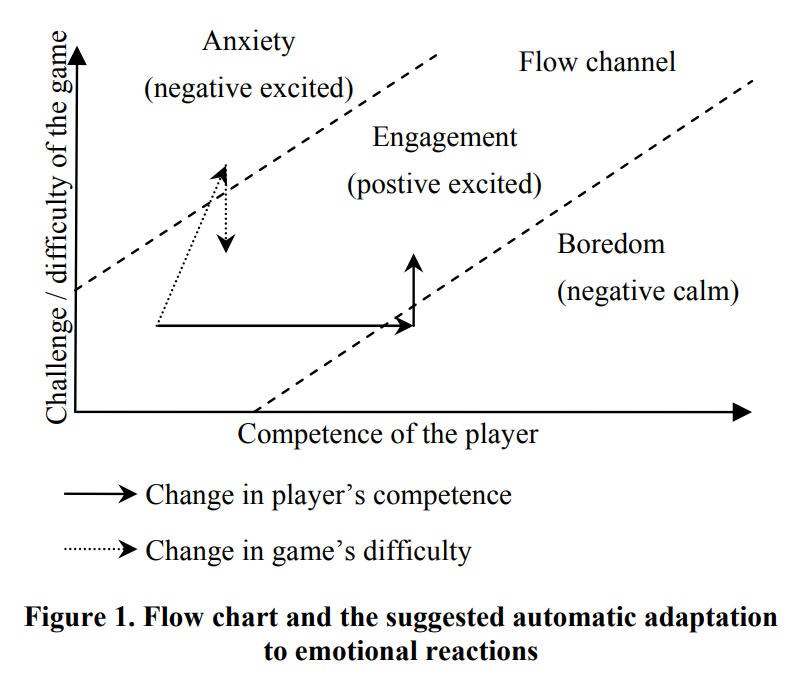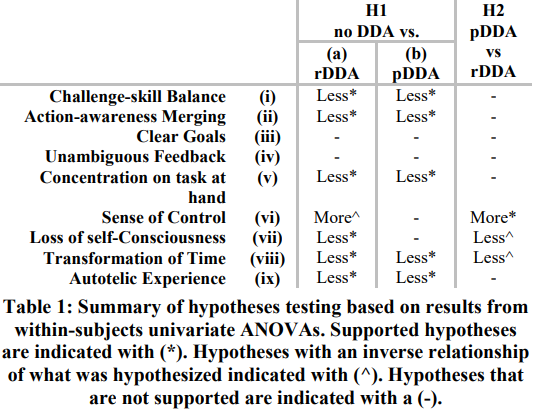Hierarchy of challenges
Flosie Sazon

The hierarchy of challenges is not a new concept to our society and the knowledge that we have to learn from the very beginning is something that is deep-rooted in it. For example, when playing sports we must follow the rules and aim to obtain a certain score for the purpose of winning, or it could be even as simple as carrying out your assignment in maths where you must understand how it works to answer a certain problem. Therefore, this paper will introduce the concept of the hierarchy of challenges first by describing the two main concepts such as the Flow theory and Dynamic Difficulty Adjustment (DDA) systems. Game developers must utilize and take into consideration to identify the most effective and suitable level of difficulty that can be applied in certain stages or modes in a game to keep the players engaged while feeling entertained simultaneously without experiencing boredom. Furthermore, this paper will describe how to apply the hierarchy of challenges in order to encourage students to learn through game-based learning.
Flow theory
The term Flow was first introduced by Csikszentmihalyi in 1990. Flow can be seen as a state of mind in which the player reaches a certain level of focus during an activity. In this state of Flow, players are in better control of their skills and the challenges they face. These elements can anticipate engagement and immersion and it is also proven that it is an effective method to understand learning. According to a study conducted by Hamari, J., et al (2016), educational video games have been proven to be effective and have a positive effect on students’ engagement through learning activities. Additionally, the levels of engagement such as concentration, interest, and enjoyment can be activated by increasing the level of difficulty and skill during the game. Skills and challenges can identify the four flow conditions such as flow, boredom, anxiety, and empathy and as you break down these conditions, players will have a more balanced experience between the challenges and their skills in the game.
Flow experiences can also be wrapped around between concentration, interest, and enjoyment when it comes to learning based on the Shernoff theory (2013). On the other hand, according to Csikszentmihalyi et al., (1993), concentration is the centre of flow and interest attracts attention which can arouse a desire in the players to keep them engaged in the activity that is related to learning, while enjoyment provides a sense of achievement when it comes to challenges and performances.

Therefore, it is important to know how each type of Flow can be used to keep the player immersed in the game. Apart from Flow, game developers must also consider how the many levels of difficulty can be applied within the game based on the skills of the player which can be identified by testing the different types of Dynamic Difficulty Adjustment (DDA).
Dynamic Difficulty Adjustment
For the purpose of a game to be playable while keeping the players engaged throughout gameplay sessions without bringing them to a state of boredom, game designers and developers utilize Dynamic Difficulty Adjustment (DDA). This system helps them to balance the difficulty against the player’s expertise while playing further DDA can also be used to control the difficulty adjustment instead of the game design itself. There are also different types of DDA systems, one of them being the system-oriented ramping DDA (rDDA), which increases the difficulty automatically based on player performance. Another one is the player-oriented DDA (pDDA), which provides a direct manipulation of the player over the difficulty level using Ang, D., and Mitchell, A. (2017) study. Lastly, the multiplayer DDA (mDDA) where the player’s avatar assets are directly affected such as its abilities, navigation, and resources instead of affecting the outside environment to the player or the opposing player (Baldwin et al., 2013). The most important goal that DDA systems must accomplish is to achieve the “optimal spot” during game challenges while helping the players improve their skills providing them with a better game experience.
The effects of DDA Systems
After conducting several experiments on the use of DDA to control the level of difficulty in the game, it was found that DDA systems affect positively on the game experience and, furthermore, Flow cannot properly work without the DDA. Nevertheless, rDDA had a negative effect on the game experience when the players were facing a lack of sense of control. Because pDDA increases the player’s self-consciousness and awareness of time,it is deemed better than the rest of DDA systems. These results are from the study conducted by Ang, D., and Mitchell, A., in 2017. In conclusion, it is particularly important to know how to apply the diverse types of DDA in games, to control the level of difficulty because they can produce a massive impact on the game flow. It can also affect the game experience of the player negatively or positively depending on how they cope with the level of difficulty that is applied. This also suggests that game developers must attempt to utilize the several types of DDA and conduct an experiment before making a decision to apply for the game.

How the level of difficulty can affect player engagement
In relation to the flow and emotion theories, when a player’s potential skills reach the level of difficulty within the game, this increases their engagement. Notwithstanding the fact that if the game has a variety of difficulties during gameplay, there is a high possibility that the player’s anxiety will increase, even though it is not to the extent that could cause boredom. After performing several experiments about adjusting the level of difficulty within a game, they suggested that playing a game at a particular level of difficulty and depending on the skill each player has, several emotional states rise such as boredom, engagement, and anxiety conducted by Chanel et al., in 2008 about how to keep the player engaged by maintaining the difficulty and interconnecting its emotion recognition. It was proposed that if the level of difficulty did not completely change in a game, the engagement of the players decreases. This also established that the level of difficulty must be balanced according to the empathy of the player. However, recognizing the difficulty is not as stable considering its changes over time, as soon as the players started to enhance their skills (Goetschalckx, Missura et al., 2010). In a good computer or video game, you are always playing on the very edge of your skill level, always on the brink of falling off, you feel the urge to climb back on. That is because there is virtually nothing as engaging as this state of working at the very limits of your ability. (p.24) – McGonigal (2011) On the contrary, the player will only remain engaged in a game if the level of difficulty is balanced within their expertise as it encourages them to continue their efforts on completing the challenge to have a sense of achievement in return. This also concludes how games can be essential to education to maintain the students’ absorption in learning.
How can students be engaged, and immersed through game-based learning?
Games develop and adapt rapidly, resulting in advanced tools that can be used as a part of the education system. Nowadays, they have become an essential resource for teachers and students no matter the level of knowledge they have from primary school, all the way to college, game-based activities are used to teach and learn. The study from the article, “Challenging Games Help Students Learn: An Empirical Study on Engagement, Flow, and Immersion in Game-Based Learning” by (Hamari et al. 2016,) proves that students show more engagement in learning activities through educational video games, as what the researchers have anticipated on the level of engagement such as concentration, interest, and engagement. This can be activated by upgrading the level of difficulty and skill during gameplay as mentioned in the section above. It was also suggested that there was no massive effect when students are engaged in the game through immersion, and it was only affected by identifying the challenge directly and along with high engagement. In relation to Coller and Shernoff (2009) observations, students who usually participate in a game-based format lecture while completing their tasks and assignments tend to be more engaged in the activity than those who complete their work regularly.

Students prefer to work when difficulty is implemented in the tasks they perform as they become more motivated and immersed when they are being challenged through complex problems. They also feel more accomplished, and their confidence increases after passing through a difficult level. It was also proven that if students concentrate, their instinct tells them that their game performance is going well, and they are expecting to succeed. On the contrary, as students lose their focus, they could sense that there will be an upcoming obstacle causing them to feel uneasy during the flow state, with a reference to (Csikszentmihalyi, 1990). The investigation also revealed that if the level of difficulty increases, the more the students concentrate on the game (Shernoff, 2010) suggested. Although in some cases, students feel overpowered by the challenges when they are beginning to learn a new skill as some of the obstacles are not suitable to their current ability. For that reason, they must reach the right level of skills needed to match the difficulty of the challenge, and when they get to accomplish this stage, the level of difficulty will keep increasing repeatedly. However, this is not the case for other students who prefer doing easier tasks as they are self-conscious and hesitant to take risks.
Furthermore, (Valve, 2007, 2011) developed a design framework called “layered learning” which enhances the learning elements steadily while associating them to the principles of challenges, skills, engagement, and immersion. This means that it is particularly significant to maintain the player’s skills as well as keeping them engaged and learning simultaneously while playing the game. It is also important to note that every student has different capacities and levels of expertise and, therefore, it is necessary to maintain the appropriate level of difficulty. A big gap between the skills and level of a game can cause the loss of attention for a particular game and a mistake on the game developer’s part. The ability to adapt to the player and its skills is crucial for a successful game-player intervention.
Conclusion
The hierarchy of challenges is substantially important when developing a game due to the fact that without implementing the appropriate level of difficulty, the game will not attract the players to continue playing as they will fall into a state of boredom. Game-based learning is also proven to be effective for students as they become more immersed, and their confidence increases after completing a complex task. Although there is a possibility that students can lose focus if their current ability will not be able to reach the level of difficulty. Consequently, the game must have a sense of stability between the level of difficulty and skill for the player within a certain phase to enhance their engagement, such as their concentration and enjoyment. The findings above also suggest how the flow experience and DDA work concurrently, as flow concentrates on the psychological aspect while DDA assists the players to be further engaged apart from controlling the difficulty of the game. Once game developers identify these important methods, they will be able to develop a playable game that people could enjoy for a significant period of time.
Bibliography
Ang, D. and Mitchell, A. (Oct 15, 2017) Comparing Effects of Dynamic Difficulty Adjustment Systems on Video Game Experience: ACM.
Baldwin, A., Johnson, D. and Wyeth, P. (Apr 26, 2014) The Effect of Multiplayer Dynamic Difficulty Adjustment on the Player Experience of Video Games: ACM.
Chanel, G., Rebetez, C., Bétrancourt, M. and Pun, T. (Oct 07, 2008) Boredom, Engagement and Anxiety as Indicators for Adaptation to Difficulty in Games : ACM.
Hamari, J., Shernoff, D.J., Rowe, E., Coller, B., Asbell-Clarke, J., and Edwards, T. (2016) ‘Challenging Games Help Students Learn: An Empirical Study on Engagement, Flow and Immersion in Game-Based Learning’. Computers in Human Behaviour, Vol. 54 170-179.
Kumar, A., Etheredge, J. and Boudreaux, A. (2012) ‘Understanding and Implementing Adaptive Difficulty Adjustment in Video Games’ In Algorithmic and Architectural Gaming Design: Implementation and Development, Anonymous: IGI Global, 82-106.
Yu-Tzu, C., Sunny, S.J.L., Chaoyang, C. and Eric Zhi-Feng, L. (2011) ‘Exploring Online Game Players’ Flow Experiences and Positive Affect’. TOJET the Turkish Online Journal of Educational Technology, Vol. 10 (1).
Author

Flosie Sazon is a second-year student in Technological University of Dublin based in Blanchardstown Campus studying a Creative Digital Media course. She chose this course as it has a variety of different mediums that she can learn and experience. Since she is still unsure of what career she wants to do, this course was perfect for her as doing art is her best skill. Flosie was able to experience different mediums such as photography, creating games, building a website, making films, and most importantly, she was able to enhance her design skills through this course.

